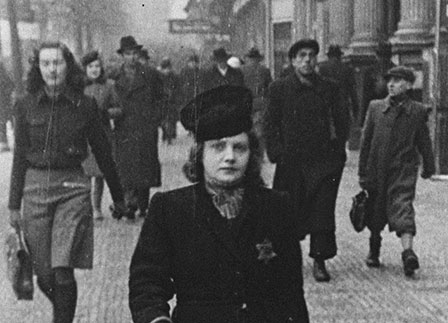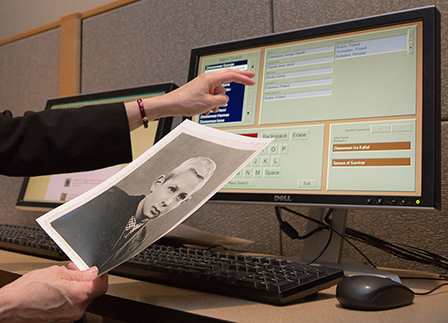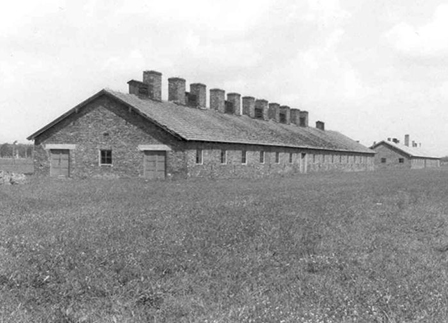Overview
- Brief Narrative
- Suitcase used by 14 year old Bertl Rosenfelt when she and two younger sisters, Edith, 13, and Ruth, 9, left Nazi Germany in March 1939 on a Kindertransport to Great Britain. After Hitler assumed power in Germany in 1933, Jews were subjected to increasingly punitive restrictions. Bertl's extended family tried to get visas for the US, but were unsuccessful because of the strict US quotas. Bertl, Edith, and Ruth were sent to Aachen to live with Friederika in 1937 to attend the Jewish school. During the Kristallnacht pogrom on November 9-10, 1938, they passed the burning synagogue and were told their school was closed. A maternal aunt, Hannah (Johanna) had lived in London since 1933. She found people willing to take in the sisters and Friederika arranged for their departure on the Kindertransport. They left in March 1939 and 2 year old Esther was sent in June. Bertl's parents Adolf and Katty were murdered in August 1942 in Auschwitz concentration camp. In 1947, Bertl fulfilled her mother's wishes by arranging for all the sisters to go to America, where her brother was already living.
- Date
-
use:
approximately 1939 March-1947 November
- Geography
-
received:
Adelsheim (Germany)
use: Kindertransport; Great Britain
- Credit Line
- United States Holocaust Memorial Museum Collection, Gift of Bertl Rosenfeld Esenstad
- Contributor
-
Subject:
Bertl R. Esenstad
- Biography
-
Bertl (Bertha) Rosenfeld (Rosenfelt) was born on October 28, 1925, in Korb, Germany, the eldest child of Adolf and Katherine (Katty) Lemburger Rosenfeld. She was born in the same bed, in the same house, as her father had been born. Adolf was born on June 16, 1898, into a large Jewish family of 10-13 children. He was the next to youngest child, and was in business with his younger brother. Adolf was a veteran of the First World War, during which he lost a leg. He was cattle dealer, and also sold livestock feed and supplies. Katty was born on June 18, 1999, in Rexingen to Simon and Babette Frohrlich Lemberger, also a large family of 10-13, with at least three sisters. About a year after Bertl’s birth, the family moved to Adelsheim. It had a larger Jewish community and the synagogue had enough male members to form the minyan needed for certain religious rites. Adolf and Katty had four more children: Edith, born on February 17, 1926, Ruth born on August 11, 1930, Herman, born on April 27, 1933, and Esther, born on April 3, 1927.
In January 1933, Hitler was appointed Chancellor and began to put into practice the Nazi pledge to persecute Jews. Soon Jews were barred from certain professions and people were encouraged to boycott Jewish owned businesses. The older children attended public school until the mid-1930s, when, as Jews, they were prohibited from attending. Bertl, Edith, and Ruth went briefly to live with relatives and attend a Jewish school in Heilbronn. They were then sent to live with their maternal aunts Friedel (Friederike) and her sister, in Aachen where there was a Jewish school. On November 9 or 10, 1938, the time of the Kristallnacht pogrom, they passed the burning synagogue as they walked to school. They were told to return home and the school was closed. Bertl remembers that there would sometimes be people in her aunt’s home at night, who would be gone in the morning, although it was only later she realized that Friedel was helping to smuggle them across the border. The home was raided by the Gestapo, who turned over the furniture as they searched for evidence. The family had many relatives in the United States who provided the affidavits of support needed to get US visas. However, because of the restrictive US quotas, it was not possible to get visas for everyone. Bertl’s father said that his younger brother should leave first, because he, Adolf, had his veteran’s pension for support. The extended family agreed and this uncle and his family left for the US. In March 1939, one of the aunt’s arranged for the children to leave for Great Britain on the Kindertransport (Children’s Transport), a rescue mission to save Jewish children. Another of their mother’s sisters, Johanna, had worked in London as a domestic and then chef since 1933 and she was able to find families willing to provide homes for the girls. Bertl, Edith, and Ruth left Germany in March 1939 and two year old Esther was sent in June 1939.
Bertl was placed with a non-Jewish family, the Poole’s, in the London suburbs. Edith was placed with a Jewish family and Ruth with a Jewish doctor named Nickels(?) associated with Bloomsbury House. Ruth later moved to a hostel. Esther was sent to live with Dorothy and Harry Harrison and their son Alan in Thorpe, Norwich, England. In September 1939, the war began when Germany invaded Poland. The Poole’s and Bertl went to Scotland to stay in Mrs. Poole’s native village. The sisters lived in different areas of England, but did manage to visit occasionally. On October 22, 1940, Bertl’s parents and brother were arrested by the Gestapo in Adelsheim and deported to Gurs internment camp in France. On March 30, 1941, they were transferred to Rivesaltes internment camp. Her brother Herman, 8, was rescued from there in September 1941 and sent by private relief efforts to the United States. His uncles Sally and Sigmund Rosenfeld, both residents of Washington DC, saw Herman's name in a list of refugees published in an American German newspaper and Herman went to live with Sally and his wife. Friedel died of tubercolisis in March 1941. Bertl and her aunt Hannah (Johanna) continued to receive letters from her mother Katty. Bertl had to go to work when she turned sixteen in October 1941. Her aunt found her a room and a job in London. Bertl saved her money and sent what she could to her parents. In 1942, the Quakers working at the camp returned Bertl’s money because her parents were no longer there.
The war ended on May 7, 1945. Bertl later learned some details of the fate of her parents. On August 2, 1942, they were sent from Rivesaltes to Drancy transit camp in Paris. From there, they were deported and murdered in Auschwitz concentration camp. Friedel died of tubercolisis in March 1941. Other family members also perished.
In 1947, Bertl, following directions given to her by their mother, arranged for Esther, Ruth, and herself to go America. Edith was a member of the British Army, and would join them upon her discharge. Ruth left first on the Batory, arriving on November 7 and Bertl and Esther sailed on the Queen Mary, arriving a couple weeks later in November. At first, they lived with the aunt and uncle in Washington DC who had taken in their brother Herman. When Edith joined them in October 1948, she and Bertl got an apartment and moved there with Esther. Ruth was the first to attend college, receiving a bachelor's degree at the University of Maryland, and then a teaching certificate in Philadelphia, where she taught first grade. Ruth married David Hirsh Ezekiel in 1952 and had three children. Bertl married Morris Esenstad (1920-2012), a World War II veteran, in 1954. They had two children. When Esther left for college at the University of Illinois, she lived with her sister Ruth and her husband. She married Fred Starobin (1925-2011) and they had two children. Bertl’s brother Herman, age 57, died in 1990. Her sister Edith Kaye, age 71, died in 1998. Ruth, age 79, died in 2009.
Physical Details
- Language
- English
- Classification
-
Containers
- Category
-
Luggage
- Object Type
-
Suitcases (aat)
- Physical Description
- Rectangular, fiberboard suitcase covered with shiny, coated black cloth with a white cloth covered wooden frame and 3 stop lid hinges. The lid and base rims are reinforced with a black painted metal strip. The case has light brown leather edging stitched with offwhite thread and leather corner reinforcements. A stiff leather handle, with red strings tied around it, is attached by D-rings to leather tabs on the base front. There are 2 tarnished, silver colored hasps riveted on the lid front and 2 lock plates with a hasp slot and sliding keyhole release riveted on the base front. There are 4 metal foot studs on the back and on the underside corners. The interior is lined with discolored white cloth and has 4 offwhite cloth straps, 1 with a metal bracket, attached to the base frame and 2 joined, gathered, cloth pockets attached across the lid. On the left corner is a metal lid stay. Paper labels and remnants are adhered to the exterior. The suitcase is heavily scratched, dented, and stained.
- Dimensions
- overall: Height: 7.875 inches (20.003 cm) | Width: 27.375 inches (69.533 cm) | Depth: 17.125 inches (43.498 cm)
- Materials
- overall : fiberboard, cloth, wood, metal, leather, thread, paper, ink, adhesive
- Inscription
- lid, lower left sticker, black ink : CAB(IN?) CLA(S?) / AND
lid, center, sticker, preprinted, handwritten, black and white ink : (?) ARD WHITE STAR / Miss B Rosenfelt : (handwritten) / (N?)AME OF SHIP Queen Mary : (handwritten) / CLASS PASSENGER Cabin. (handwritten) / DATE OF (SA?)ILING Nov 5 (handwritten) ROOM No. D157. (handwritten) / M (PORT) Southampton. (handwritten) / (?) (E?)ROOM BAGGAGE/ (?)GAGE INSURANCE - A SAFE POLICY / PRINTED IN ENGLAND
lid, lower right sticker, black ink : (?)BIN CL(A?)(?) / AND
right side sticker, black ink : 674326B 674326B / UNITED STATES / CUSTOMS SERVICE / DATE / INSPECTOR
Rights & Restrictions
- Conditions on Access
- No restrictions on access
- Conditions on Use
- No restrictions on use
Keywords & Subjects
- Topical Term
- Holocaust, Jewish (1939-1945)--Germany--Personal narratives, Jewish. Jewish children in the Holocaust--Germany--Biography. Jewish refugees--Great Britain--Biography. Jews--Rescue--Germany--Biography. Kindertransports (Rescue operations)--Great Britain--Personal narratives, German. World War, 1939-1945--Refugees--Great Britain--Personal narratives, German.
Administrative Notes
- Legal Status
- Permanent Collection
- Provenance
- The suitcase was donated to the United States Holocaust Memorial Museum in 2000 by Bertl Rosenfelt Esenstad.
- Funding Note
- The cataloging of this artifact has been supported by a grant from the Conference on Jewish Material Claims Against Germany.
- Record last modified:
- 2022-07-28 21:51:02
- This page:
- http://collections.ushmm.org/search/catalog/irn13892
Download & Licensing
In-Person Research
- By Appointment
- Request 21 Days in Advance of Visit
- Plan a Research Visit
- Request to See This Object
Contact Us
Also in Bertl Rosenfeld Esenstad collection
The collection consists of four pillowcases and a suitcase relating to the experiences of Bertl Rosenfeld during and after the Holocaust when she and her three sisters were sent on a Kindertransport from Germany to Great Britain in 1939, and later emigrated to the United States.
Date: approximately 1939
Drawn threadwork pillowcase with the embroidered initials KR used by a German Jewish Kindertransport refugee
Object
Whitework pillowcase used by 14 year old Bertl Rosenfelt when she and two younger sisters, Edith, 13, and Ruth, 9, left Nazi Germany in March 1939 on a Kindertransport to Great Britain. It was made by her maternal aunt Friederika Lemberger and embroidered with Bertl's mother's initials, KR, Katherine Rosenfelt. After Hitler assumed power in Germany in 1933, Jews were subjected to increasingly punitive restrictions. Bertl's extended family tried to get visas for the US, but were unsuccessful because of the strict US quotas. Bertl, Edith, and Ruth were sent to Aachen to live with Friederika in 1937 to attend the Jewish school. During the Kristallnacht pogrom on November 9-10, 1938, they passed the burning synagogue and were told their school was closed. A maternal aunt, Hannah (Johanna) had lived in London since 1933. She found people willing to take in the sisters and Friederika arranged for their departure on the Kindertransport. They left in March 1939 and 2 year old Esther was sent in June. Bertl's parents Adolf and Katty were murdered in August 1942 in Auschwitz concentration camp. In 1947, Bertl fulfilled her mother's wishes by arranging for all the sisters to go to America, where her brother was already living.
Pillowcase with cutwork flowers and the embroidered initials FL used by a German Jewish Kindertransport refugee
Object
Pillowcase with cutwork embroidery used by 14 year old Bertl Rosenfelt when she and two younger sisters, Edith, 13, and Ruth, 9, left Nazi Germany in March 1939 on a Kindertransport to Great Britain. It was made by her maternal aunt Friederika Lemberger and embroidered with her initials, FL. After Hitler assumed power in Germany in 1933, Jews were subjected to increasingly punitive restrictions. Bertl's extended family tried to get visas for the US, but were unsuccessful because of the strict US quotas. Bertl, Edith, and Ruth were sent to Aachen to live with Friederika in 1937 to attend the Jewish school. During the Kristallnacht pogrom on November 9-10, 1938, they passed the burning synagogue and were told their school was closed. A maternal aunt, Hannah (Johanna) had lived in London since 1933. She found people willing to take in the sisters and Friederika arranged for their departure on the Kindertransport. They left in March 1939 and 2 year old Esther was sent in June. Bertl's parents Adolf and Katty were murdered in August 1942 in Auschwitz concentration camp. In 1947, Bertl fulfilled her mother's wishes by arranging for all the sisters to go to America, where her brother was already living.
Monogrammed pillowcase with whitework embroidery used by a German Jewish Kindertransport refugee
Object
Monogrammed pillowcase with an eyelet design used by 14 year old Bertl Rosenfelt when she and two younger sisters, Edith, 13, and Ruth, 9, left Nazi Germany in March 1939 on a Kindertransport to Great Britain. It was made by her maternal aunt Friederika Lemberger from a converted pillow sham with her initials FL. After Hitler assumed power in Germany in 1933, Jews were subjected to increasingly punitive restrictions. Bertl's extended family tried to get visas for the US, but were unsuccessful because of the strict US quotas. Bertl, Edith, and Ruth were sent to Aachen to live with Friederika in 1937 to attend the Jewish school. During the Kristallnacht pogrom on November 9-10, 1938, they passed the burning synagogue and were told their school was closed. A maternal aunt, Hannah (Johanna) had lived in London since 1933. She found people willing to take in the sisters and Friederika arranged for their departure on the Kindertransport. They left in March 1939 and 2 year old Esther was sent in June. Bertl's parents Adolf and Katty were murdered in August 1942 in Auschwitz concentration camp. In 1947, Bertl fulfilled her mother's wishes by arranging for all the sisters to go to America, where her brother was already living.
Monogrammed pillowcase with whitework embroidery used by a German Jewish Kindertransport refugee
Object
Monogrammed pillowcase wth an eyelet design used by 14 year old Bertl Rosenfelt when she and two younger sisters, Edith, 13, and Ruth, 9, left Nazi Germany in March 1939 on a Kindertransport to Great Britain. It was made by her maternal aunt Friederika Lemberger from a converted pillow sham with her initials FL. After Hitler assumed power in Germany in 1933, Jews were subjected to increasingly punitive restrictions. Bertl's extended family tried to get visas for the US, but were unsuccessful bcause of the strict US quotas. Bertl, Edith, and Ruth were sent to Aachen to live with Friederika in 1937 to attend the Jewish school. During the Kristallnacht pogrom on November 9-10, 1938, they passed the burning synagogue and were told their school was closed. A maternal aunt, Hannah (Johanna) had lived in London since 1933. She found people willing to take in the sisters and Friederika arranged for their departure on the Kindertransport. They left in March 1939 and 2 year old Esther was sent in June. Bertl's parents Adolf and Katty were murdered in August 1942 in Auschwitz concentration camp. In 1947, Bertl fulfilled her mother's wishes by arranging for all the sisters to go to America, where her brother was already living.



